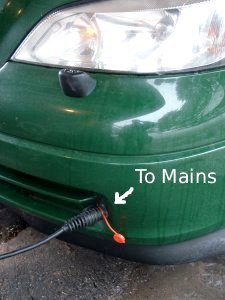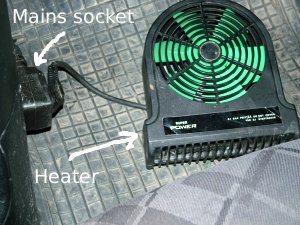|
Improving your gas mileage day by day MilesGallon.com - Gas Mileage CalculatorFind Out Your Real MPG and Learn How to Improve It Remember to Turn of the A/CIt’s still summer and some days can be really hot. Remember that as soon as you turn on the A/C you could be loosing as much as 10MPG, the A/C is a real power hog. Do this:
Do this and save some gas during hot summer days! Dedicated to improving your fuel economy, Simon Byholm
Is Your Gas Cap Missing?With the hot summer weather soon here I want to share with you a summer time gas saving tip. It’s one of the tips you can get for free in our email cource on saving gas I must admit that before I started researching fuel economy I had no idea that driving without a gas cap would make any significant difference to my fuel economy, But it does! Loosing your gas cap and not replacing it can cost you up to 15 gallons of gas a year, and even more if you live in a hot climate. With no lid on the gas tank fuel will constantly evaporate from the tank into the air. Poof, gone… Not only will you loose fuel but the extra gas added to the atmosphere will contribute to the greenhouse effect. If you loose our gas cap, immediately go buy a new one from your car dealer or local mechanic. You will pay less for the new cap than for all the fuel you loose without a cap. This technique may give you savings of 3 mpg or more depending on how hot and dry the climate is around you and if you have an additional lid on top of the missing gas cap that prevents some of the leakage. Dedicated to improving you fuel economy, Simon Byholm P.S. To find out your real MPG just use our free gas calculator, or try the metric mileage calculator if you’re from outside the United States.
Worst Mileage EverI just added my last tank to my gaslog at gassavers.org and it turned out to be my worst tank ever with this car. The milage ended up being 37mpg which is a lot less than my record of 42.5 mpg and mean mileage of 41 mpg. I suspect it’s the winter temperatures that’s now below zero that’s affecting the mileage. On my 15km commute the engine just about reaches working temperature at the end of the ride even when using the block heater for two hours before takeing off. I will just have to wait for the next fillup to see if the trend is permanent. Dedicated to improving your fuel economy, Simon Byholm P.S. I use the automotive conversion calculator to convert mileage and fuel amounts between American and European units.
Pictures of My Car Heating System
The first part is the timer that lets me connect the heating when I get home from work and have it turn on two to four hours before I go to work the next day. I use two hours during the mild part of winter and four hours when it’s really cold.
Inside the car the cabling goes to the block heater and to the inside heating fan. The cable outside the car should be made of oil and cold resistant material as otherwise it will get stiff as a stick and oil on the ground can eat through normal cabling.
As you can see it’s pretty crowded in the engine compartment so I didn’t find where the heater is located but it does work so I believe it’s where it’s supposed to be.
The block heater helps with mileage as the engine uses less fuel when warm and the inside heater lets me take off immediatly instead of idling for five minutes while taking the ice off the windows. It also make the driving a lot more comfortable as the engine does not heat up enought to provide much heat during my 15 mintue commute. Dedicated to improving your mileage, Simon Byholm
It’s Time For The Block HeaterIf you live up in the north like me, now is the time to find the engine heater, or in my case the power cord for the block heater. It near freezing temperatures here and I have started to use the block heater during the colder nights to save fuel when starting,  remember a cold engine uses a lot of fuel. It’s a good idea to remind the rest of the family that there’s a cable attached to the car, otherwise you might end up with a broken cable or timer. Talking about the timer, I always put the timer on two hours when it’s still mild temperatures to not waste electricity. Keep the winter driving safe, Ha ha says my wife. Simon
Save Gas In Hot and Cold WeatherThis is an article I just wrote. It is going to be part of the fuel saving lessons you can via email at the Gas Mileage Calculator page. It’s about some of the ways you can save gas when it’s really hot or when it’s freezing temperatures. Save Gas When It’s HOT or COLD Did you know that when it’s really hot in summer and when Really Hot Weather, And How to Save The number #1 gas thief in summer is the air condition. It’s Too bad it’s not as easy as just turning the AC off. Ok, The problem is what you do after you turn the A/C off, The problems with the windows is that driving above 30mph This means if you go faster than 30mph it’s better to use If it’s really hot you might want to use the A/C even You can still save by setting the indoor temperature a bit It’s also a good way to prevent getting a summer cold to not Now to a completely different aspect of hot weather, make sure This is essential as the car will get extremely hot when left Another thin you can do to prevent loosing fuel is to fill up There is two reasons for this. One is the same as above, fuel Easy, fill up before the sun goes up. Or at least before it Now to Cold Weather, Freezing Weather The colder it is the more you can save. Not because of Step one: Get a block heater. That’s important both for your fuel economy and for the The block heater uses electricity from the mains to A cold engine will not be able to burn fuel efficiently, The cold engine also doesn’t get lubricated well enough, That was to say you have a double benefit, even a triple Another thing, if you use winter/snow tires, in most Make sure you switch to summer tires as soon as it’s WHERE TO GET AN ENGINE HEATER If you are one of our US readers and need an engine It’s a magnetic heater that you can easily attach Kats 200W Magnetic Heater from Amazon Use that link to see the heater. It can also be used Dedicated to improving your fuel economy, Simon Byholm Where I live in Finland almost every car has a block heater installed. If you don’t have a block heater in the coldest weeks in February your car might not start. And even if it does start it will be smoking, without power and a real pain to drive until it warms up. If you have story to tell about how you save gas in hot and cold weather just leave a comment here below this post.
Copyright (C) 2006-2023 Text Ad King and MilesGallon.com - Gas Mileage Calculator
|
 I thought some of your may not have seen any engine heating system if you live south and as this one is connected to the Finnish electricity grid you won’t recognice the electricity connectors if you live outsitde this part of Europe.
I thought some of your may not have seen any engine heating system if you live south and as this one is connected to the Finnish electricity grid you won’t recognice the electricity connectors if you live outsitde this part of Europe. Then theres the cable connecting the mains from the timer to the car. Theres a small handy socket in the front left of the car where I plug in the power, we also have a couple of heating sockets at work so if I’m in time I can have heater on also before leaving for home.
Then theres the cable connecting the mains from the timer to the car. Theres a small handy socket in the front left of the car where I plug in the power, we also have a couple of heating sockets at work so if I’m in time I can have heater on also before leaving for home. I included a pic of the engine even though you can’t see the heater, it’s a block heater and if you could see it it would just be a cable going into the engine block as the heater is inside the engine heating the coolant.
I included a pic of the engine even though you can’t see the heater, it’s a block heater and if you could see it it would just be a cable going into the engine block as the heater is inside the engine heating the coolant. The other part of the heating system is a heating fan heating the inside of the car making it more comfortable and melting ice of the windows saving me five minutes of idling and manual ice-removal.
The other part of the heating system is a heating fan heating the inside of the car making it more comfortable and melting ice of the windows saving me five minutes of idling and manual ice-removal.